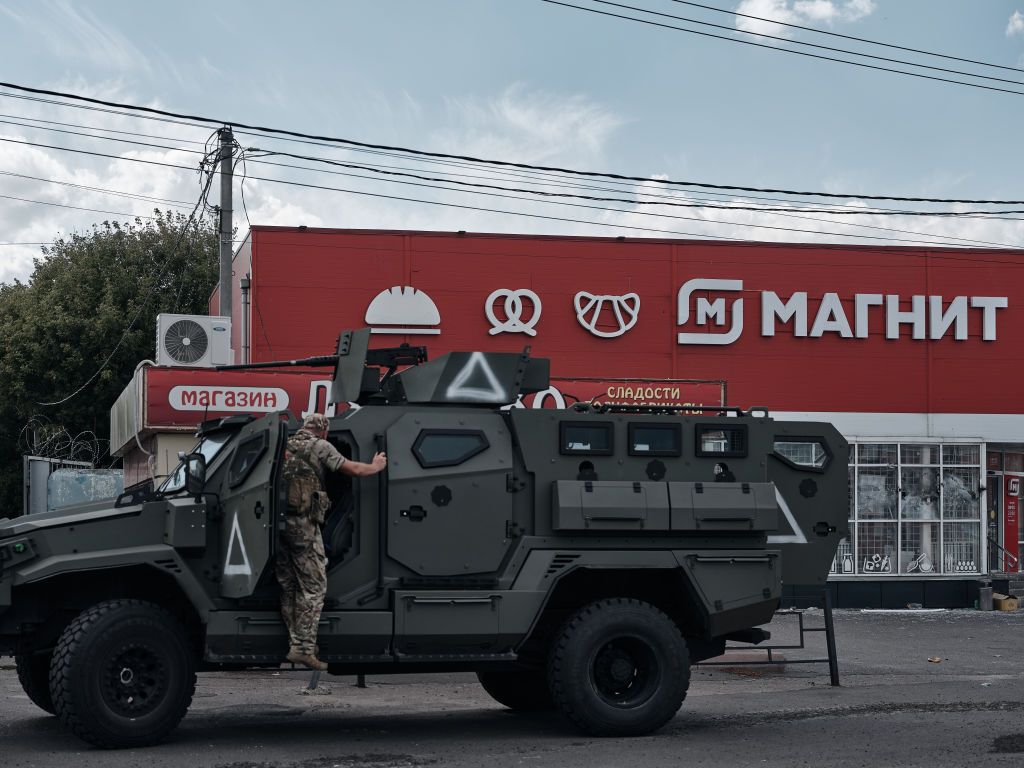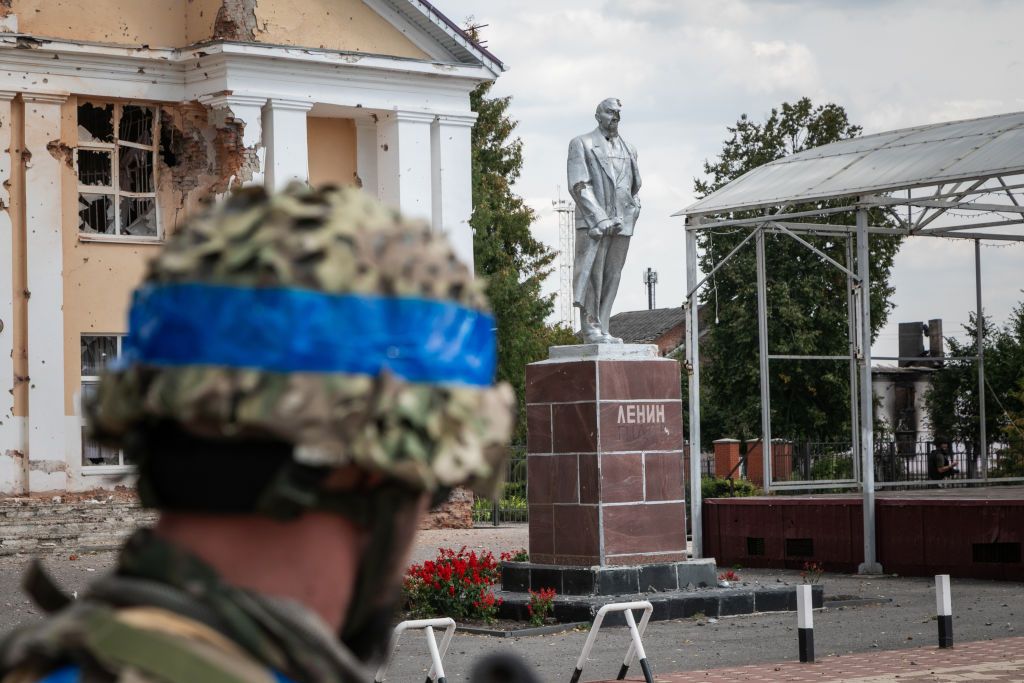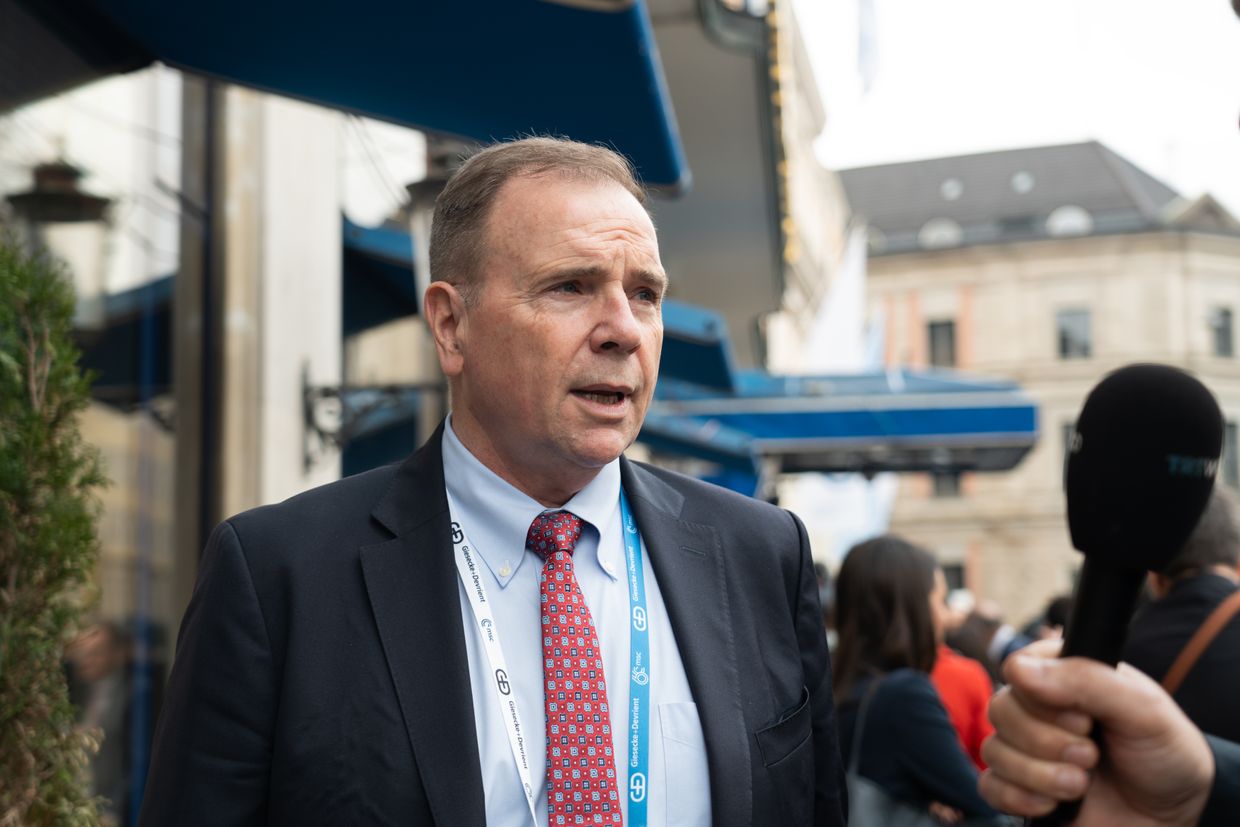
Kursk operation: What Ukraine achieved so far and potential future gains
Can the bold incursion into Russia bring the victory closer for Ukraine?
The border checkpoint, destroyed during the ongoing Ukrainian operation in Russia's Kursk Oblast, seen with the sign "Ukraine" and "Russia" on Aug. 16, 2024, in Sudzha, Russia. (Kostiantyn Liberov/Libkos/Getty Images)
Ukraine’s ongoing operation in Russia’s Kursk Oblast, a bold incursion launched nearly three weeks ago that surprised Moscow and the world alike, has already yielded some tangible military and political results while also raising hopes for a sooner end to Russia’s full-scale invasion.
The Kursk incursion has allowed Ukraine to set a precedent for further offensive actions. It has created conditions for returning more Ukrainian prisoners of war by capturing scores of Russian POWs. The first major invasion of Russia since World War II has also dealt a blow to Russian President Vladimir Putin’s reputation while lifting the spirits of Ukrainian soldiers and civilians.
Experts believe it could also strengthen Ukraine’s position in potential peace negotiations, bolster support from Western allies, and potentially incite doubt about the war in Russia and possibly even sow unrest.
"The success of this operation shows that Ukrainian forces can not only defend but also effectively go on the offensive, which expands our tactical capabilities and serves as a model for other regions," Tymofiy Mylovanov, head of Kyiv School of Economics, told the Kyiv Independent.
"In addition, the operation in Kursk contributes to the strengthening of internal unity in Ukraine, increasing the authority of our Armed Forces in the international arena, and may also force the Kremlin to reassess its military plans."

Since Ukrainian forces began the offensive in Kursk Oblast on Aug. 6 from the bordering Sumy Oblast, they have advanced up to 35 kilometers into Russian territory. Hundreds of Russian soldiers are estimated to have been captured since.
According to Oleksandr Syrskyi, commander-in-chief of Ukraine's Armed Forces, Ukraine controls the town of Sudzha, where a strategic gas metering station involved in the transit of blue fuel through Ukraine to Europe is based, and over 90 surrounding settlements. Ukrainian forces have also destroyed all three bridges over the Seim River to encircle Russian forces in the area.
The Kursk operation is taking place against the backdrop of brutal battles more than 400 kilometers to the south in Ukraine’s eastern Donbas region, where Russian forces are putting immense pressure on Ukrainian defenses.
There is a growing concern that Russian occupation may be imminent for the strategically important road junction city of Pokrovsk in Donetsk Oblast, with Russian troops just 10 kilometers away.

Ukraine’s achievements due to Kursk incursion
One of Ukraine’s reported objectives in the Kursk incursion was to force Russia to divert some of its resources away from the Donbas battlefields. While Moscow seems to have redeployed some troops to Kursk Oblast, it hasn’t been enough to significantly impact the Donbas front line, especially in the most vulnerable areas like Pokrovsk and Toretsk, according to experts interviewed by the Kyiv Independent.
Despite this, the Kursk offensive has already come at a considerable cost to Russia, with Ukraine capturing the largest number of POWs in a single operation to date. Zelensky announced that "hundreds" of Russian soldiers had been captured. A Ukrainian colonel, speaking on condition of anonymity due to not having the authority to reveal certain information to the public, told The Independent that the figure could be as high as 2,000.
“Hopefully, this will mean many Russian-held Ukrainian warriors will get to return home,” said John Hardie, deputy director of the Russia Program at the Foundation for Defense of Democracies.
Ukrainian officials previously said that negotiating POW exchanges with Russia has become increasingly challenging as the battlefield situation in Donbas has shifted in favor of Russia’s month-long grinding offensive. It has come at a huge manpower cost for Moscow, whose army has incurred massive losses while achieving gradual territorial gains over 10 months.
In the latest prisoner exchange on Aug. 24, Ukraine’s Independence Day, 115 Ukrainian soldiers were brought back from Russian captivity. The Russian Defense Ministry said on the same day that 115 Russian POWs who were captured during the ongoing Ukrainian operation in Kursk Oblast were returned from Ukrainian custody.

Ukraine’s rapid advance into Kursk Oblast and Russia's lack of a robust response has exposed Moscow’s weaknesses, serving as a reminder that even Russia's vast resources are not limitless and undefeatable. Russian and Ukrainian bloggers claimed that the Chechen Akhmat battalion, which was supposed to defend the Kursk border, abandoned its positions, underscoring serious command issues within the Russian military.
As a result of the operation, the Russian border area opposite Ukraine’s Sumy Oblast has been “mostly cleared of Russian military presence,” Zelensky said on Aug. 19, calling it one of Kyiv’s tactical goals for the incursion. Sumy Oblast, which was partially occupied by Russia at the beginning of the full-scale invasion, has endured daily shelling and frequent cross-border raids since its liberation in April 2022.
Putin, meanwhile, has attempted to downplay the incursion as a “terror attack.” Experts say that the Kursk incursion has challenged the image of Putin as a “great protector “ and brought more frustration to Russian citizens who believed their lives would remain distant from the war.
Meanwhile, Ukrainian forces once again demonstrated their ability to surprise the enemy. They regained the initiative on the battlefield after suffering a series of setbacks in eastern and southern Ukraine since last year.

“In the information space, the Kursk operation has been successful. It has shifted the focus away from Ukraine's problems to its achievements,” said Emil Kastehelmi, an OSINT analyst with the Finland-based Black Bird Group and a military history expert, in a comment to the Kyiv Independent.
“People are talking less about Russian gains in the east and more about Ukraine successfully taking Russian villages,” he added.
“That’s a real morale boost on the Ukrainian side… And it (the Kursk operation) has damaged morale on the Russian side. We’ve seen all of these prisoners surrendering, and civilians complaining loudly to their government that they're not being taken care of and they're being forgotten,” said William Taylor, vice president for Europe and Russia at the U.S. Institute of Peace and former U.S. Ambassador to Ukraine.
“It’s also a morale boost for Ukraine’s supporters in Europe, Canada, the United States, Japan, South Korea, and Australia. Supporters are very pleased to see Ukrainian success on the battlefield, which should encourage them to continue and even increase their support.”
Peace talks leverage
One of Kyiv's key long-term objectives in the Kursk operation appears to be gaining leverage in potential peace talk negotiations with Moscow. The captured Russian territory could serve as a bargaining chip for Ukraine, which has recently struggled to secure significant battlefield victories.
Since the operation is still ongoing, it's uncertain how much leverage Ukraine will actually have at the negotiating table. Kastehelmi suggests that while a direct trade of territories based on square meters controlled by each side is unlikely, Ukraine might seek to exchange the land captured in Kursk Oblast for the territories in Kharkiv Oblast that Russia occupied during its latest offensive, as these areas are "kind of comparable."
“The Kremlin did not expect such a blow, and this increases their willingness to negotiate, although they try to hide it,” Mylovanov said, adding that the incursion “has the potential to significantly improve Kyiv's position in future peace negotiations.”
“Putin is trying to downplay the operation, limiting media coverage and refocusing attention on humanitarian aid to victims as if it were a natural disaster,” he added.
“Russia is losing face, and they are going to great lengths to save it. This means that our leverage is working, and if Ukraine continues in the same spirit, it will only increase our chances for successful peace negotiations and the return of Ukrainian territories.”
Chipping away at stability in Russia
If the Kursk incursion expands in both time and territory, it could deepen doubts about Putin’s ability to win the war and preserve stability within his own country. This, in turn, could over time, trigger unrest in Russia itself, particularly among residents of border regions and the families of conscripts sent to fight against Ukrainian forces with no combat experience.
Anxiety levels among Russians have risen since the incursion, comparable to the surge in fear recorded after the Moscow concert hall attack in March, according to a Russian state-controlled pollster, F.O.M. The poll also showed that 25% of Russians were dissatisfied with the Kremlin’s actions, the highest level of discontent since July 2023, when Wagner Group boss Yevgeny Prigozhin launched a short-lived armed rebellion against Moscow.

“At present, the negative reactions are aimed more at the local authorities for shortcomings in the organization of evacuation and other technical aspects, which is in line with the strategy of Putin, who positions these events as a natural disaster and focuses on humanitarian support,” said Mylovanov.
“This may work in the short term, but over time the effectiveness of this strategy will diminish when displaced people are unable to receive quality care and find a new life.”
Shattered 'red lines' lift Kyiv's hopes for more weaponry
Putin has barely said anything about the incursion, and the threats of using nuclear weapons in response to an attack on what Moscow considers its territory — frequently heard throughout the full-scale invasion — have notably disappeared during the Kursk operation.
This muted response has challenged the narrative of the Kremlin's "red lines," which Western nations have been cautious to cross. This could encourage Kyiv’s allies to lift restrictions on the use of their long-range weapons against targets on Russian territory and to increase their support for other Ukrainian requests, according to Kastehelmi.
A week after Ukraine started its Kursk operation, a source close to Zelensky's administration told the Kyiv Independent that discussions between Ukraine and U.S. President Joe Biden's administration about supplies of long-range cruise missiles were "in the advanced stages."
“Although we have yet to see an official decision to allow the use of long-range weapons, the rhetoric is already changing. In addition, we see that the armored vehicles of Western partners are already in use on the territory of Russia,” said Mylovanov.
“The Kursk operation highlights the importance of pushing the Russians away from the Ukrainian border,” Taylor said, adding that the U.S. may soon allow Ukraine to strike deeper into Russian territory, beyond just the border areas, as currently permitted.
“In the past, these decisions have taken months to finalize. I hope this one comes sooner,” Taylor said.
Note from the author:
Hi there, this is Dinara Khalilova, the author of this article. I hope you enjoyed reading about Ukraine’s wins in Russia's Kursk region. We need your support to continue reporting on Ukrainian successes on the battlefield and the challenges the country faces in its fight against Russian aggression. Please consider becoming a member of the Kyiv Independent community.













